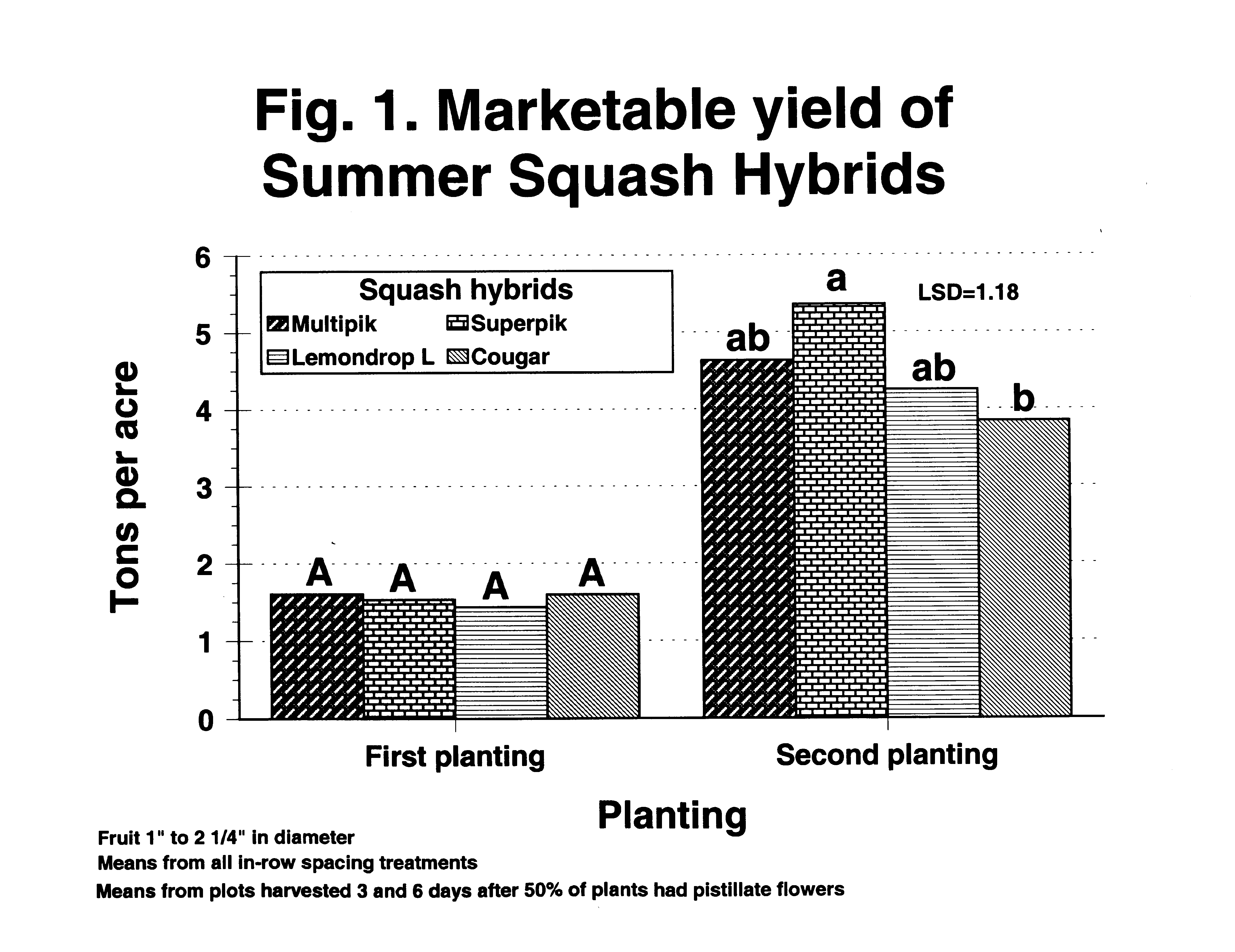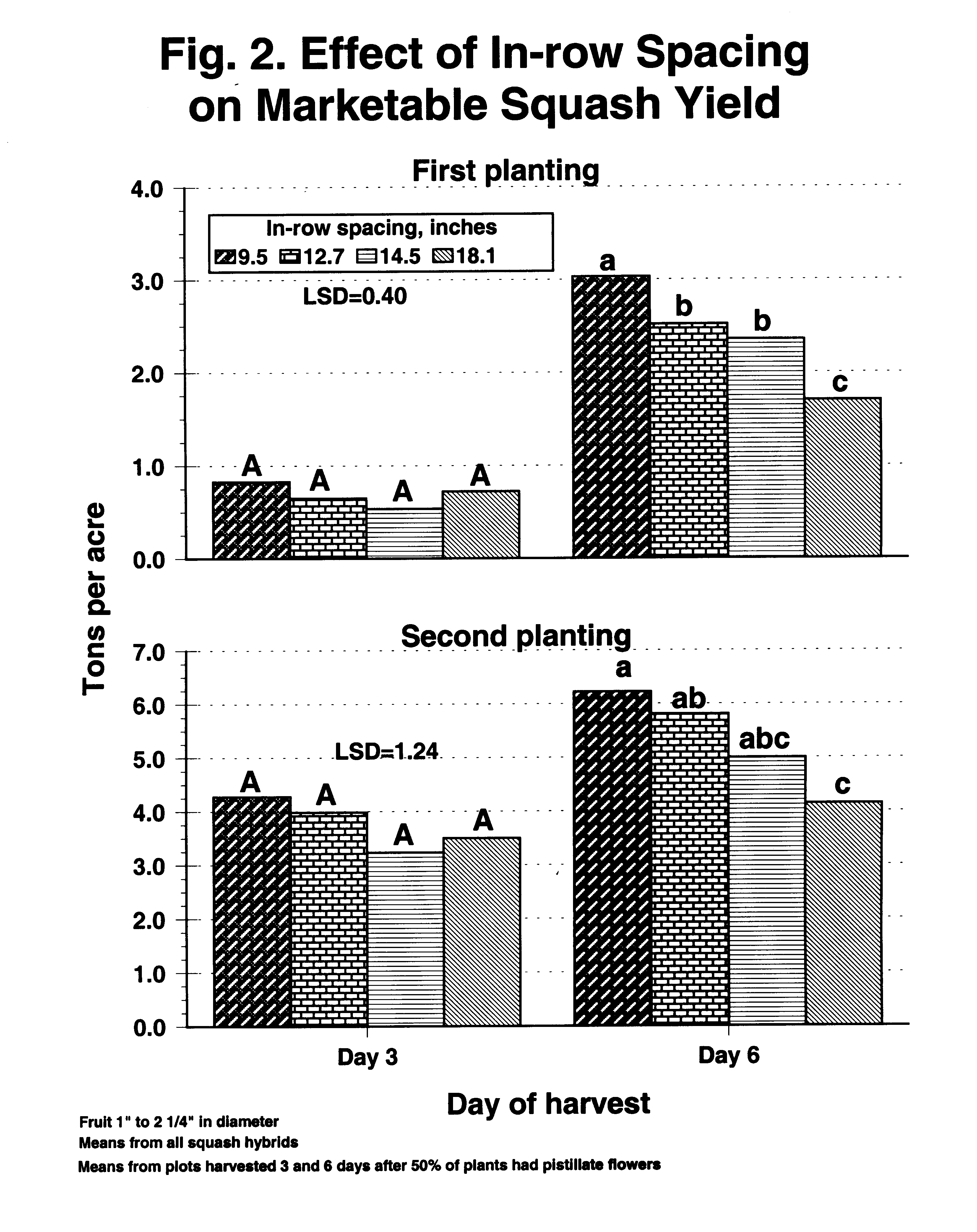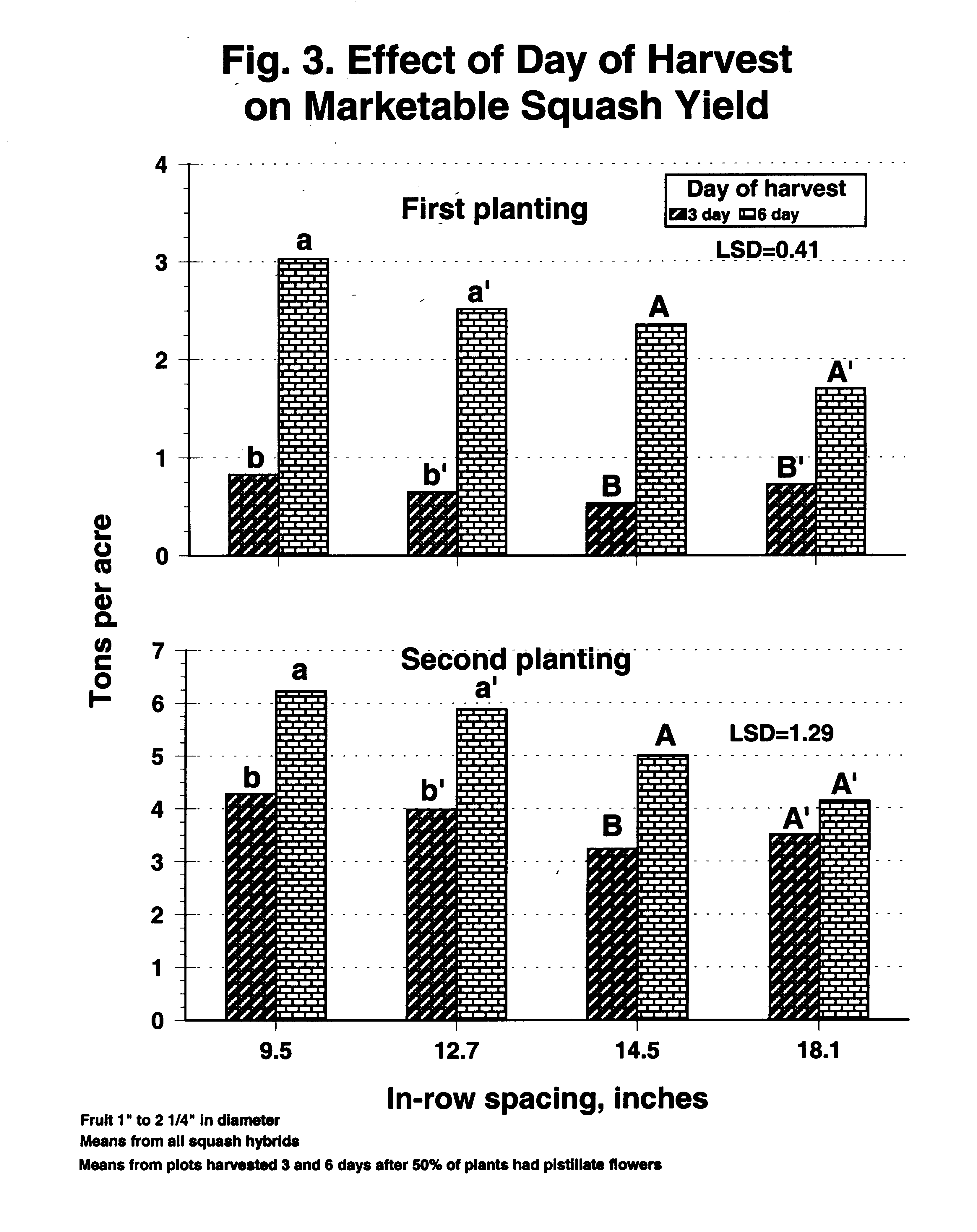Scheduling Harvest of Summer Squash to Maximize Once-over Yield, WTES
Jim E. Wyatt and Craig H. Canaday
West Tennessee Experiment Station
Interpretative Summary
Two summer squash plantings were made in the summer of 2001 to study the effects of squash hybrids, plant spacing and time of harvest on once-over yields. No differences were found among squash hybrids in the first planting but ‘Superpik’ was the highest yielding hybrid in the second planting. To maximize yields in a once-over, destructive harvest of summer squash, the plant population should be at least 22,000 plants per acre and harvest should occur at least 6 days after half the plants have started producing pistillate flowers.
Introduction
Summer squash (Cucurbita pepo L.) is an annual vegetable which usually produces marketable fruit over a period of several weeks. For this reason, fruit harvest has not been mechanized to any great extent but it might be economically feasible if a reasonably large number of marketable fruit could be harvested at the beginning of the production season. Objectives of this study were 1) to determine the optimum in-row spacing for producing the maximum yield of marketable squash, 2) to identify summer squash hybrids which would produce a concentrated amount of fruit, and 3) to develop an objective method of determining the optimum harvest time to maximize yields.
Materials and Methods
Summer squash tests were planted at the West Tennessee Experiment Station on June 12 and June 28. The plot area was prepared by disking and broadcasting 400 lbs/A of 15-15-15 and 4 qt/A of Diazinon insecticide and incorporating with a spring tooth harrow followed by a rolling basket to smooth the soil surface. Treatments were 1) in-row spacing, 2) squash hybrids, and 3) harvest dates. The experiment was arranged in a split-split plot design with four replications. Main plots were summer squash hybrids ‘Multipik’, ‘Superpik’, ‘Lemondrop L’, and ‘Cougar’. Subplots were in-row spacings with seeds planted by a Monosem pneumatic planter (A. T. I., Inc., Lexena, KS) set to deliver seeds at 9.5, 12.7, 14.5, and 18.1 inches apart in the row. Sub-subplots were harvest dates with plots picked to simulate once-over harvesting of all fruit at either three or six days after the day that 50% of plants in a plot had produced a pistillate flower.
Plots were grown using recommendations for summer squash production in Tennessee. Numbers of open pistillate flowers were recorded daily in each plot when anthesis began. When the number of plants in a plot with pistillate flowers reached 50% of the total (hereinafter called the "harvest
initiation day"), plots were marked for harvest either three or six days later. At harvest, all fruit one day past anthesis and older were picked. Fruit were graded by size into three categories: 1) those less than 1 inch in diameter, 2) those 1 to 2.25 inches in diameter, and 3) those over 2.25 inches in diameter. Total weight of fruit from each category was recorded.
Data were analyzed by analysis of variance using appropriate SAS (SAS Institute, Inc., Cary, NC) procedures. Mean separation was by LSD.
Results and Discussion
In-row spacing of summer squash plants was slightly closer than predicted by planting charts, gear settings and seed plates of the planters which we used (Table 1). This resulted in increases in per-acre populations ranging from 4.1 to 7.3 percent more than expected. This is assuming all seed emerged and produced a normal plant.
Table 1. Comparison of predicted spacings from planter settings with actual in-row spacing and the resulting per acre population differences.
|
Predicted spacings |
Measured in-row |
Predicted per spacingsz |
Possible acre populations |
Percent increase populationsy |
|
9.5 |
9.1d |
22045a |
22977a |
4.2 |
|
12.7 |
11.7c |
16907b |
17871 |
7.9 |
|
14.5 |
13.8b |
14048c |
15151 |
4.8 |
|
18.1 |
17.0a |
11435d |
12299 |
5.6 |
z
Means followed by the same letter are not significantly different, Duncan’s multiple range test, 5% level. N=40.y
With perfect standNo differences were found in marketable fruit yield among summer squash hybrids for the first planting (Fig. 1). Yields were relatively low, possibly due to lack of pollination, since staminate flowers did not develop in the test for about five days after the beginning of pistillate flower anthesis. This normally results in aborted fruit or abnormal fruit development since ovules and seed do not develop in the fruit.
In the second planting, ‘Superpik’ was the highest yielding squash hybrid with about 5.3 tons of marketable fruit per acre (Fig. 1). This yield was higher than the yield of ‘Cougar’ but not significantly different than ‘Multipik’ or ‘Lemondrop L’.

In-row spacing had a significant effect on marketable yield on the sixth day following the harvest initiation day, but not on the third day (Fig. 2). There was a steady and fairly linear decrease in marketable yield as in-row spacing of plants increased from 9.5 to 18.1 inches.
In the first planting, marketable yields were increased by at least 200 to 400 percent, depending on spacing, by delaying harvest from three to six days after the harvest initiation day (Fig. 3). In the second planting, yields were significantly higher at six days compared to three days after harvest initiation day except for squash spaced 18.1 inches apart. Squash fruit achieve much of their final size in the period from 2 to 6 days after anthesis.


Almost no over-sized fruit were produced when the first planting was harvested at three days after the harvest initiation day (Fig. 4), but three days later over-sized fruit in some plots exceeded 1 ton per acre in some spacing treatments. This demonstrates how rapidly the fruit were growing during this period and how critical it would be to harvest at the proper time to maximize marketable yields.
In the second planting, over-sized fruit harvested at six days after the harvest initiation day exceeded those harvested at three days (Fig. 4) but the difference was significant only at the 12.7 inch spacing treatment. By six days after harvest initiation day, over 3 tons per acre of over-sized fruit were being produced by some treatments. Over-sized fruit will be a factor to consider in a once-over mechanical harvest system. At some point in the operation, the fruit that are not marketable due to size will require separation from those that are acceptable. Ideally, the over-sized fruit would be left in the field but will still need to be handled, either by hand or mechanically.
